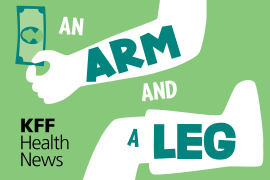Research Roundup: Putting Good Science Into Practice
Every week, Kaiser Health News reporter Shefali S. Kulkarni compiles a selection of recently released health policy studies and briefs.
Archives of Internal Medicine: Impact Of National Clinical Guideline Recommendations For Revascularization Of Persistently Occluded Infarct-Related Arteries On Clinical Practice In The United States -- In 2006, researchers published a widely reported study showing that for many patients who had suffered a heart attack more than 24 hours before and had a blocked coronary artery, certain heart procedures, such as balloon angioplasty and the insertion of stents, were no more effective than drugs alone. In 2007, the American Heart Association and the American College of Cardiology issued guidelines urging doctors to not use such treatments in those patients. This new study explores whether doctors have been swayed by that information when making decisions about treatments. The authors, using data from from 896 hospitals and 28,780 patient visits, report that just over half of the patients in the study still underwent the heart treatment. That means there was "no significant decline" in use since the 2006 study, they write (Deyell, et. al, 7/11).
Archives of Internal Medicine: Food Deserts Or Food Swamps? -- This study examines neighborhoods with little access to healthy foods, often called food deserts, to see if recent efforts to limit fast food restaurants and recruit grocery stores is effective in improving food choices of residents. Using 15 years of longitudinal data from four U.S. cities, the researchers found that fast food consumption was related to easy access, especially for men living within about a half mile to a little less than 2 miles of a restaurant. Access to a grocery market was not related to the quality of diets in the neighborhood. "We found evidence that low-income men may be sensitive to fast food availability within shorter distances from home, but findings for women and higher-income men were mixed. Supermarket and grocery store availability were generally unrelated to diet" (Boone-Heinonen, et. al, 7/11).
Health Affairs: Hospitals Respond To Medicare Payment Shortfalls By Both Shifting Costs And Cutting Them, Based On Market Concentration -- One goal of the 2010 federal health care law is to slow Medicare spending on hospitals. But some critics of that policy have argued it will cause hospitals to raise costs for privately insured patients. The author of this study analyzed 2008 data for more than 30,000 private and Medicare patients who had one of seven major procedures at a hospital, such as knee or hip replacements, coronary angioplasty or insertion of a cardiac pacemaker to see how hospitals reacted when facing a shortfall between Medicare reimbursements and costs. "Faced with shortfalls between payments and projected costs, hospitals can either increase prices to private insurers or reduce costs, or both," he wrote. Those responses are not incompatible and he found that "hospitals in concentrated markets focus on raising prices to private insurers, while hospitals in competitive markets focus on cutting costs" (Robinson, 7/1).
National Bureau of Economic Research/Robert Wood Johnson Foundation: The Labor Market Impact of Employer Health Benefit Mandates -- The authors of this issue brief studied San Francisco's 2008 pay-or-play policy that "requires employers to either provide health benefits or contribute to a public option health plan." They found that "employment and earnings patterns in San Francisco did not change appreciably following the policy. This was true for industries most affected by the mandate, as well as for overall private sector employment. ... These results indicate that while little of the burden of the mandate fell on San Francisco workers, approximately half of the incidence of the mandate fell on consumers." They believe the results could be applicable to the current debate over similar, but not identical, provisions in the federal health law (Colla, Dow and Dube, 7/6).
New England Journal of Medicine: Health Care Spending and Quality In Year 1 Of The Alternative Quality Contract -- This study looks at the effects on ambulatory care from a 2009 Blue Cross Blue Shield program in Massachusetts called Alternative Quality Contract (AQC). Programs in the the AQC run similar to accountable care organizations--where doctors, hospitals and other health care providers bear the financial risk and are even eligible for financial bonuses for quality medical care. The results show a "modest slowing of spending growth and improved quality of care in 2009. Savings were achieved through changes in referral patterns rather than through changes in utilization" (Song, et. al, 7/13).
Robert Wood Johnson Foundation/Urban Institute: Consider Savings As Well As Costs -- This issue brief seeks to identify areas where states will save money under the 2010 health law. Although states will see increased funding requirements under the law, the authors find that the total state savings "would exceed states' new costs, as federal dollars substitute for projected state and local spending without the (law) and as states eliminate current Medicaid eligibility for adults who qualify for federal subsidies." States would also see savings in a drop in the amount of uncompensated care and in increased federal funding for coverage of people with mental illnesses (Buettgens, Dorn and Carroll, 7/11).
Journal Of The American Medical Association: Medicaid Payment Levels to Dentists And Access To Dental Care Among Children And Adolescents -- This study focuses on the relationship between Medicaid payments to dentists and the access to dental care received by children and adolescents. Researchers compared data from the National Health Interview Survey from 2000-2001 and 2008-2009 and Medicaid dental fees from 2000 and 2008. The study's author found Medicaid payments for dental services, on average, "did not change significantly in inflation-adjusted terms between 2000 and 2008," although payments went up in five states and the District of Columbia. She also found that increases in payments "were positively associated with use of dental care among children and adolescents covered by Medicaid. For example, a $10 increase in the Medicaid prophylaxis payment level (from $20 to $30) was associated with a 3.92 percentage point (95% CI, 0.54-7.50) increase in the chance that a child or adolescent covered by Medicaid had seen a dentist" (Decker, 7/13).
The Institute of Medicine: Improving Access To Oral Health Care For Vulnerable And Underserved Populations -- This report finds that millions of Americans are not getting adequate dental care because of "persistent and systemic" barriers. The authors say that one of out every 16 children in 2008 did not receive care "because their families could not afford it." In addition, they said, access problems affect others, including minority groups, people with low incomes, older adults, pregnant women and people in rural areas. The IOM recommends a number of policy changes to help improve access, including increased Medicaid reimbursements for dental care and demonstration projects to help provide dental care to adult enrollees of Medicaid. Among them is making changes in state law to allow dental hygienistsand other professionals to practice "to the full extent of their training," expanding dental education programs and enhancing training to handle more diverse patients, and expanding dental options at federally qualified community health centers (7/14).
Related, from KHN's Capsules blog: Give Teeth A Chance, Says New IOM Report (Gold, 7/13).
This is part of the Morning Briefing, a summary of health policy coverage from major news organizations. Sign up for an email subscription.





